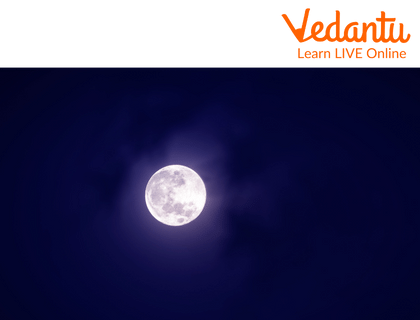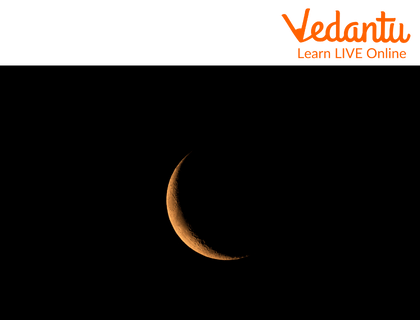




The Science Behind the Moon’s Glow: Key Concepts and Examples
Who does not love to see the Moon increasing and reducing in size at night? It is the brightest of all the celestial bodies shining at night. Do you know that Moon does not have its own light like the stars? How does it shine then? Let us find out the scientific reason behind the shining of the Moon.
What is the Moon?
The Moon is the natural satellite of the earth. It revolves around the earth and completes a round in 28 days. These 28 days is called lunar month. Do you know that other planets in our Solar System have moons? Moon is the 5th largest in size.
How Does the Moon Shine at Night?
Unlike the stars and our Sun, the Moon does not have its own light. It is a solid round object, similar to a planet, which does not produce or emit light of its own.
The night Moon, as mentioned earlier, does not produce its light. Then, how does it shine every night? Why does the shining part of the moon increase and reduce in size? Sometimes, we see a full moon and sometimes, it vanishes from the sky. Why does it happen? Let us find out the answers to all these questions.

The Full Moon
Moon is not a good reflector of sunlight. The sunlight falls on the Moon’s surface in the same way it falls on the earth. The Moon's surface then reflects back the sunlight and looks illuminated to our eyes.
We all know that our earth is in 3rd place in the Solar System after Mercury and Venus. It means we are quite close to the Sun and so is Moon. The amount of light falling on the surface of the Moon is enough to make it illuminated.
During the daytime, we cannot see the Moon as it hides in the pure sunlight falling on us. At night, we don’t receive sunlight and the night sky appears dark. In this dark background, the Moon reflecting sunlight becomes more prominent. This is why the Moon shines by reflecting the sunlight at night.
Did You Know?
The size of the Moon remains the same but the reflecting surface area reduces and increases across a month. It happens due to the full, partial, or no exposure of the Moon’s surface to the sun rays that we can see.
We see a full circle or a full Moon glowing at night when the visible surface is circular in size. We see a crescent moon or a half moon when the illuminated surface is partially seen from the earth. We see a new moon or no moon at all when the illuminated surface is away from us. The dark surface of the moon is not visible to us at night.
You will also be surprised to know that the Moon absorbs the maximum of the sun rays falling on its surface. It only reflects back 12% of the sun rays incident on it. Despite this fact, the Moon seems to glow more than the stars. It happens due to the shorter distance between the Moon and the earth than the stars.

The Crescent Moon
Tips for Parents
Explain how the Moon gets light to the kids by using drawings and images. It is ideal to explain this topic using pictorial illustration. Kids will love to understand this scientific fact of the Moon shining at night using sun rays. They will also learn the concepts of the new moon and the full moon.
FAQs on How Does the Moon Shine?
1. How does the Moon shine if it has no light of its own?
The Moon shines because its surface reflects sunlight. It does not produce any light on its own, like the Sun does. Think of it as a giant, dusty mirror in space that bounces the Sun's bright light down to us on Earth, making it visible in the night sky.
2. Why does the Moon appear to change its shape throughout the month?
The Moon is always a round sphere, but it appears to change shape because of its orbit around the Earth. As the Moon travels, we see different amounts of its sunlit half. These changing views are called the phases of the Moon. We see everything from a thin crescent to a full circle (Full Moon) depending on the Moon's position relative to the Sun and Earth.
3. Why does the Moon look much bigger than the stars?
The Moon looks bigger than the stars simply because it is much closer to the Earth. Stars are actually giant, glowing balls of gas, many of which are far larger than the Moon. However, they are so incredibly far away that they appear as tiny points of light, while the much closer Moon appears as a large disc in our sky.
4. If the Moon reflects sunlight, why do we see it at night when the Sun is gone?
We see the Moon at night because even though our side of the Earth is in darkness, the Moon is high up in space where it can still be hit by the Sun's light. The sunlight travels from the Sun, bounces off the Moon's surface, and then travels through space to our eyes on the night side of the Earth. The Moon can often be seen during the daytime as well!
5. What is the difference between the light from the Sun and the light we see from the Moon?
The key difference lies in the source of the light.
- Sun's Light: The Sun is a star and produces its own light and heat through nuclear reactions. It is the original source of light in our solar system.
- Moon's Light: The Moon does not produce any light. The light we see from it is secondhand; it is reflected sunlight. This is why moonlight is much dimmer and cooler than sunlight.
6. What happens when the Earth blocks the sunlight from reaching the Moon?
When the Earth moves directly between the Sun and the full Moon, it casts a shadow on the Moon, preventing sunlight from reaching it. This event is known as a lunar eclipse. During a total lunar eclipse, the Moon can look dim and sometimes turn a reddish colour because a small amount of sunlight is filtered and bent through Earth's atmosphere.
7. What is a 'New Moon' and why is it invisible to us?
A 'New Moon' is a phase that occurs when the Moon is located between the Earth and the Sun. During this time, the side of the Moon that is illuminated by the Sun is facing away from the Earth. The side facing us is in complete shadow, making the Moon invisible in our sky, even though it is still there.
8. How does the rough, dusty surface of the Moon help it shine?
The Moon's surface is not smooth like a polished mirror. It is covered in rock, dust, and craters. When sunlight hits this rough, uneven surface, it doesn't just bounce off in one direction. Instead, it scatters in all directions. This scattering ensures that some of the sunlight is always reflected towards Earth, regardless of the Moon's exact angle, allowing us to see it glow.





















